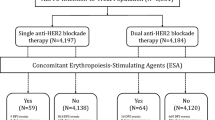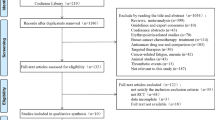Abstract
Current clinical guidelines state that the use of erythropoiesis-stimulating agents (ESAs) may be considered to treat chemotherapy-induced anemia in the non-curative setting to alleviate anemia-related symptoms. However, no convincing survival benefit has been demonstrated to support the use of ESAs in these patients. Using the comprehensive data collected in the National Cancer Institute (NCI)-surveillance epidemiology and end results (SEER) and Medicare-linked database, we analyzed the effect of ESA use on the short-term (18-month) and long-term (60-month) survival rates of chemotherapy-treated metastatic breast cancer patients. Confounding variables were adjusted using a propensity score approach. We also analyzed the effects of ESA on the survival of patients receiving trastuzumab, a commonly prescribed targeted therapy agent in treating HER2-positive tumors. Metastatic breast cancer patients who received ESA treatment exhibited similar 60-month survival rate to those without ESA treatment (22.8 vs. 24.9 %, p = 0.8). ESA-treated patients had a trend toward better 18-month survival [crude hazard ratio (HR) 0.86, 95 % confidence intervals (CI) 0.68–1.09, p = 0.21]. This protective effect during the first 18 months of chemotherapy became marginally significant after adjusting for the propensity of receiving ESAs (HR 0.80, 95 % CI 0.63–1.01, p = 0.070). An interaction effect between ESA and trastuzumab on patient survival was noticeable but not statistically significant. ESAs did not negatively affect the long-term survival of metastatic breast cancer patients. Moreover, ESAs improved patients’ survival during the first 18 months of chemotherapy treatment. These findings endorse the current clinical guideline. Given the short survival of these patients, the potential short-term beneficial effects of ESAs are clinically meaningful.



Similar content being viewed by others
References
Glaser CM, Millesi W, Kornek GV, Lang S, Schull B, Watzinger F, Selzer E, Lavey RS (2001) Impact of hemoglobin level and use of recombinant erythropoietin on efficacy of preoperative chemoradiation therapy for squamous cell carcinoma of the oral cavity and oropharynx. Int J Radiat Oncol Biol Phys 50:705–715
Littlewood TJ, Bajetta E, Nortier JW, Vercammen E, Rapoport B (2001) Effects of epoetin alfa on hematologic parameters and quality of life in cancer patients receiving nonplatinum chemotherapy: results of a randomized, double-blind, placebo-controlled trial. J Clin Oncol 19:2865–2874
Rodgers GM, Becker PS, Blinder M, Cella D, Chanan-Khan A, Cleeland C, Coccia PF, Djulbegovic B, Gilreath JA, Kraut EH (2012) Cancer-and chemotherapy-induced anemia. J Natl Compr Canc Netw 10:628–653
Ludwig H, Fritz E, Kotzmann H, Hocker P, Gisslinger H, Barnas U (1990) Erythropoietin treatment of anemia associated with multiple myeloma. N Engl J Med 322:1693–1699
Henke M, Laszig R, Rube C, Schafer U, Haase KD, Schilcher B, Mose S, Beer KT, Burger U, Dougherty C, Frommhold H (2003) Erythropoietin to treat head and neck cancer patients with anaemia undergoing radiotherapy: randomised, double-blind, placebo-controlled trial. Lancet 362:1255–1260
Bennett CL, Henke M, Lai SY (2008) Erythropoiesis-stimulating agents in the treatment of cancer-associated anemia—reply. JAMA 300:2855–2857
Bohlius J, Schmidlin K, Brillant C, Schwarzer G, Trelle S, Seidenfeld J, Zwahlen M, Clarke M, Weingart O, Kluge S (2009) Recombinant human erythropoiesis-stimulating agents and mortality in patients with cancer: a meta-analysis of randomised trials. Lancet 373:1532–1542
Tonelli M, Hemmelgarn B, Reiman T, Manns B, Reaume MN, Lloyd A, Wiebe N, Klarenbach S (2009) Benefits and harms of erythropoiesis-stimulating agents for anemia related to cancer: a meta-analysis. Can Med Assoc J 180:E62–E71
Leyland-Jones B, Semiglazov V, Pawlicki M, Pienkowski T, Tjulandin S, Manikhas G, Makhson A, Roth A, Dodwell D, Baselga J, Biakhov M, Valuckas K, Voznyi E, Liu X, Vercammen E (2005) Maintaining normal hemoglobin levels with epoetin alfa in mainly nonanemic patients with metastatic breast cancer receiving first-line chemotherapy: a survival study. J Clin Oncol 23:5960–5972
Schrijvers D, De Samblanx H, Roila F (2010) Erythropoiesis-stimulating agents in the treatment of anaemia in cancer patients: ESMO Clinical Practice Guidelines for use. Ann Oncol 21(Suppl 5):v244–v247
Moebus V, Jackisch C, Schneeweiss A, Huober J, Lueck HJ, du Bois A, Thomssen C, Kurbacher C, Kuhn W, Nitz U, Runnebaum IB, Hinke A, Kreienberg R, Untch M (2013) Adding epoetin alfa to intense dose-dense adjuvant chemotherapy for breast cancer: randomized clinical trial. J Natl Cancer Inst 105:1018–1026
Bohlius J, Tonia T, Nüesch E, Jüni P, Fey M, Egger M, Bernhard J (2014) Effects of erythropoiesis-stimulating agents on fatigue-and anaemia-related symptoms in cancer patients: systematic review and meta-analyses of published and unpublished data. Br J Cancer 111:33–45
Leyland-Jones B, Aapro MS, Moebus V, Nitz U, O’Shaughnessy J, Pronzato P, Untch M, Tomita D, Bohac GC (2013) Survival effects of erythropoiesis-stimulating agents (ESAs) in patients with breast cancer: a meta-analysis. In: Journal of Clinical Oncology (2013 ASCO Annual Meeting). p e20616
Mirza M, Newton M, Sager R, Kurian S, Abraham J (2010) Decline in the use of erythropoiesis-stimulating agents: long-term effects of regulation, reimbursement, and unfavorable data. In: Journal of Clinical Oncology (Meeting Abstracts). p e13158
Lai Y, Palazzo JP, Cristofanilli M, Hyslop T, Civan J, Avery T, Myers RE, Li B, Ye Z, Xing J (2014) Erythropoiesis stimulating agents and clinical outcomes of invasive breast cancer patients receiving cytotoxic chemotherapy. Breast Cancer Res Treat 148:175–185
Leyland-Jones B (2013) Erythropoiesis stimulating agents: a personal journey. J Natl Cancer Inst 105:999–1001
Goldenberg MM (1999) Trastuzumab, a recombinant DNA-derived humanized monoclonal antibody, a novel agent for the treatment of metastatic breast cancer. Clin Ther 21:309
Winer EP, Burstein HJ (2001) New combinations with Herceptin in metastatic breast cancer. Oncology 61:50–57
Hedley BD, Allan AL, Xenocostas A (2011) The role of erythropoietin and erythropoiesis-stimulating agents in tumor progression. Clin Cancer Res 17:6373–6380
Liang K, Esteva FJ, Albarracin C, Stemke-Hale K, Lu Y, Bianchini G, Yang CY, Li Y, Li X, Chen CT (2010) Recombinant human erythropoietin antagonizes trastuzumab treatment of breast cancer cells via Jak2-mediated Src activation and PTEN inactivation. Cancer Cell 18:423–435
Zhang C, Duan X, Xu L, Ye J, Zhao J, Liu Y (2012) Erythropoietin receptor expression and its relationship with trastuzumab response and resistance in HER2-positive breast cancer cells. Breast Cancer Res Treat 136:739–748
Greene FL, American Joint Committee on C, American Cancer S (2002) AJCC cancer staging handbook: from the AJCC cancer staging manual. Springer, New York
Du XL, Fang S, Vernon SW, El-Serag H, Shih YT, Davila J, Rasmus ML (2007) Racial disparities and socioeconomic status in association with survival in a large population-based cohort of elderly patients with colon cancer. Cancer 110:660–669
Hershman DL, Buono DL, Malin J, McBride R, Tsai WY, Neugut AI (2009) Patterns of use and risks associated with erythropoiesis-stimulating agents among Medicare patients with cancer. J Natl Cancer Inst 101:1633–1641
Charlson ME, Pompei P, Ales KL, MacKenzie CR (1987) A new method of classifying prognostic comorbidity in longitudinal studies: development and validation. J Chronic Dis 40:373–383
Deyo RA, Cherkin DC, Ciol MA (1992) Adapting a clinical comorbidity index for use with ICD-9-CM administrative databases. J Clin Epidemiol 45:613–619
Klabunde CN, Potosky AL, Legler JM, Warren JL (2000) Development of a comorbidity index using physician claims data. J Clin Epidemiol 53:1258–1267
Romano PS, Roos LL, Jollis JG (1993) Adapting a clinical comorbidity index for use with ICD-9-CM administrative data: differing perspectives. J Clin Epidemiol 46:1075–1079; discussion 1081–1090
Curtis LH, Hammill BG, Eisenstein EL, Kramer JM, Anstrom KJ (2007) Using inverse probability-weighted estimators in comparative effectiveness analyses with observational databases. Med Care 45:S103–S107
Xie J, Liu C (2005) Adjusted Kaplan-Meier estimator and log-rank test with inverse probability of treatment weighting for survival data. Stat Med 24:3089–3110
Austin PC (2011) An introduction to propensity score methods for reducing the effects of confounding in observational studies. Multivariate Behav Res 46:399–424
Austin PC, Mamdani MM (2006) A comparison of propensity score methods: a case-study estimating the effectiveness of post-AMI statin use. Stat Med 25:2084–2106
Loi S, Michiels S, Lambrechts D, Fumagalli D, Claes B, Kellokumpu-Lehtinen P-L, Bono P, Kataja V, Piccart MJ, Joensuu H (2013) Somatic mutation profiling and associations with prognosis and trastuzumab benefit in early breast cancer. J Natl Cancer Inst 105:960–967
Glaspy J, Crawford J, Vansteenkiste J, Henry D, Rao S, Bowers P, Berlin JA, Tomita D, Bridges K, Ludwig H (2010) Erythropoiesis-stimulating agents in oncology: a study-level meta-analysis of survival and other safety outcomes. Br J Cancer 102:301–315
Aapro M, Moebus V, Nitz U, O’Shaughnessy J, Pronzato P, Untch M, Tomita D, Bohac C, Leyland-Jones B (2015) Safety and efficacy outcomes with erythropoiesis-stimulating agents in patients with breast cancer: a meta-analysis. Ann Oncol 26:688–695
Gabrilove JL, Cleeland CS, Livingston RB, Sarokhan B, Winer E, Einhorn LH (2001) Clinical evaluation of once-weekly dosing of epoetin alfa in chemotherapy patients: improvements in hemoglobin and quality of life are similar to three-times-weekly dosing. J Clin Oncol 19:2875–2882
Desai J, Demetri GD (2005) Recombinant human erythropoietin in cancer-related anemia: an evidence-based review. Best Pract Res Clin Haematol 18:389–406
Stuben G, Thews O, Pottgen C, Knuhmann K, Vaupel P, Stuschke M (2001) Recombinant human erythropoietin increases the radiosensitivity of xenografted human tumours in anaemic nude mice. J Cancer Res Clin Oncol 127:346–350
Mittelman M, Neumann D, Peled A, Kanter P, Haran-Ghera N (2001) Erythropoietin induces tumor regression and antitumor immune responses in murine myeloma models. Proc Natl Acad Sci USA 98:5181–5186
Bennett CL, Silver SM, Djulbegovic B, Samaras AT, Blau CA, Gleason KJ, Barnato SE, Elverman KM, Courtney DM, McKoy JM, Edwards BJ, Tigue CC, Raisch DW, Yarnold PR, Dorr DA, Kuzel TM, Tallman MS, Trifilio SM, West DP, Lai SY, Henke M (2008) Venous thromboembolism and mortality associated with recombinant erythropoietin and darbepoetin administration for the treatment of cancer-associated anemia. JAMA 299:914–924
Dahabreh IJ, Linardou H, Siannis F, Fountzilas G, Murray S (2008) Trastuzumab in the adjuvant treatment of early-stage breast cancer: a systematic review and meta-analysis of randomized controlled trials. Oncologist 13:620–630
Leyland-Jones B (2003) Breast cancer trial with erythropoietin terminated unexpectedly. Lancet Oncol 4:459–460
Aapro M, Leonard RC, Barnadas A, Marangolo M, Untch M, Malamos N, Mayordomo J, Reichert D, Pedrini JL, Ukarma L (2008) Effect of once-weekly epoetin beta on survival in patients with metastatic breast cancer receiving anthracycline-and/or taxane-based chemotherapy: results of the breast cancer—anemia and the value of erythropoietin (BRAVE) study. J Clin Oncol 26:592–598
Pirker R, Ramlau RA, Schuette W, Zatloukal P, Ferreira I, Lillie T, Vansteenkiste JF (2008) Safety and efficacy of darbepoetin alfa in previously untreated extensive-stage small-cell lung cancer treated with platinum plus etoposide. J Clin Oncol 26:2342–2349
Acknowledgments
The work was supported by grants from Pennsylvania Department of Health, Thomas Jefferson University, and a Research Scholar Grant 123741-RSG-13-003-01-CCE from the American Cancer Society.
Author information
Authors and Affiliations
Corresponding author
Ethics declarations
Conflict of interest
The authors declare that they have no conflict of interest.
Electronic supplementary material
Below is the link to the electronic supplementary material.
Rights and permissions
About this article
Cite this article
Lai, Y., Ye, Z., Civan, J.M. et al. The effects of erythropoiesis-stimulating agents on the short-term and long-term survivals in metastatic breast cancer patients receiving chemotherapy: a SEER population-based study. Breast Cancer Res Treat 153, 407–416 (2015). https://doi.org/10.1007/s10549-015-3532-y
Received:
Accepted:
Published:
Issue Date:
DOI: https://doi.org/10.1007/s10549-015-3532-y




